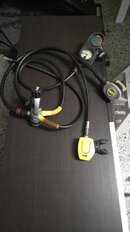That is the last model of the old style dry air bleed design. It should use a piston that has a separate module screwed into it with a laser drilled hole and a plastic filter. It’s the most capable and reliable of that design: it can actually be cleaned without clogging and replaced if necessary. (See
here for more details.)
Those are solid and high-quality, but low- to medium-end capability regulators. When tuned properly, they breathe as well as you want a regulator to breathe. But they have no features that most modern medium-range regulators have: cracking pressure adjustment, Venturi flow adjustment, etc.
Largely because they lack many of those fancy features, they also are mechanically very simple. It’s like six O-rings to rebuild the things. If you are careful, move slowly and are even a little bit mechanically inclined, they are a piece of cake to maintain.
I own a set of those regulators I use on doubles. They are actually my favorite regulators for demanding dives in high flow. They are simple and drop-dead reliable, and in the case of high flow the fact that they are not highly sensitive like most modern regs are is an advantage.
Having said that, I honestly would not put a lot of money into those regulators. If you truly have to put $250 into those regulators for them to be usable, I would seriously consider taking that money and putting them into something more modern. However, if you have ever wanted to delve into regulator maintenance and repair, these would be an excellent opportunity to dip your toes in on a design that is very straightforward.
If you have specific questions, feel free to ask. I’ve been using various models of this Sherwood design for like 20 years. I’ve used everything from what I believe to be the earliest first stages that have a big bolt shape on the end of them (and only three LP and one 3/8” HP port!), through the wavy chrome ones all the way up to the ones that you have.
For the record, if you had any model but that last model, I would say that it really isn’t worth it. Earlier models had a piston where the dry air bleed was a chunk of sintered metal that was very easy to clog, and when it got clogged the solution was to throw the piston away and buy another one. The problem is, those pistons are not straightforward to come by, and they cost like $50. Given the only mid-range performance and age of those regulators (and somewhat awkward hose routing for the earlier models) it’s probably not even worth dealing with them. (It’s even worse for the earliest models: they were built so the plastic HP seat was crimped into the piston and was not able to be replaced: Sherwood’s idea was that the piston would be replaced at each and every service!)
ETA: I didn’t really talk much about the second stages. That’s because there’s really very little to talk about. They are fixed downstream demand regulators. I prefer the model previous to these, which still had a round body and diaphragm. Supposedly, these have better breathing performance because the diaphragm is larger, but I dislike the soft purge cover and frankly just thought they looked ugly.

The functionally, though, is as good as any other fixed downstream demand regulator out there. Which means it isn’t spectacular. I think that most people probably wouldn’t notice a huge difference as long as it was properly adjusted and maintained, but people who are very sensitive to things like cracking pressure and work of breathing will not be pleased.
Again, in solid working order, I would have zero problem using those regulators. But if it took noticeably into triple digits to put them in working order, I would probably move on.




